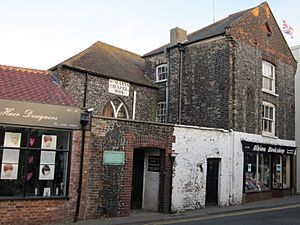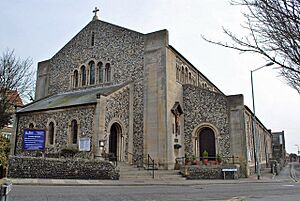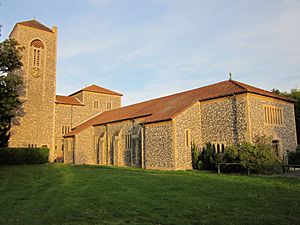Shrine of Our Lady, Bradstowe facts for kids
The Shrine of Our Ladye Star of the Sea was an ancient chapel located on the cliffs of Broadstairs. This town was once known as Bradstowe. The chapel dates back to at least the 1350s. Its two towers were an important landmark for sailors. Ships would often lower their top-sails to salute the shrine as they sailed by. This showed their respect for the special place.
Today, parts of the Chapel of St. Mary's original structure are still visible. They are built into a modern building. This building is thought to be the oldest one still standing in Broadstairs. It holds what remains of the medieval Shrine of "Our Lady of Bradstowe." You can find it near the harbour on Albion Street, where it meets Alexandra Road.
History of the Shrine
It is believed that the Shrine and its Chapel existed before the year 1070. In that year, the old Saxon Church of St. Peter's was rebuilt. It changed from a wooden building to one made of stone and flint. This church was a "daughter church" of Minster-in-Thanet.
The first chapel held the famous shrine of "Our Ladye of Bradstowe." This was a painted wooden statue of the Virgin Mary. The Royal Navy has a tradition of "showing the flag" in seaside towns. This helps keep up the spirits of the Navy. This tradition might have started at Bradstowe Chapel in 1514. The crew of the Henry Grace a Dieu attended a service there. This was when the King's largest new ship was anchored nearby. There was also a wooden cross at the top of the cliff. Chapel Stairs in Albion Street shows where steps once led down to the harbour.
Before 1514, coastal towns would often display beacons. These lights were placed on high points along the coast. They warned ships about dangers in the sea. Around 1514, Trinity House took over these duties. In medieval times, the Chapel of St. Mary was known as "The Chapel of Blue Light." This was because its light shone out into the dark sea through a blue glass lantern.
The Culmer Chapel
In the 1520s, a strong storm hit Viking Bay. It lasted for several days and caused a storm surge. This storm destroyed the Shrine and badly damaged the Chapel. A shipbuilder named George Culmer rebuilt the Chapel and replaced the Shrine.
In 1601, Sir John Culmer owned the Chapel and the land it stood on. He was one of the first Congregationalist leaders. He ordered the Chapel and its Shrine to be restored. During this time, restorations did not always keep the original building's look. Even though much of the old material was reused, the new Chapel was not as pretty as the first one. Some parts of the original ancient wall, a doorway, and a window still remain in the restored building. The Shrine of the Culmer Chapel was a statue of the Virgin Mary. It was placed on a tall column, facing the sea.
Joel Culmer was the first Pastor in 1601. For many years, ships passing by Thanet had a tradition. They would lower their top sail to salute the Shrine and Chapel. People believed this would bring good luck to their journey.
At some point, probably in 1601, the Shrine was moved inside the Chapel. After this, local sailors started calling it "The Weeping Virgin." It is said that hot weather caused moisture to build up inside the Chapel. This moisture would settle on the face of the Shrine. It made the figure look like the Virgin Mary was weeping. Religious sailors thought this was a bad sign. They believed a storm would often follow. So, changes in the Chapel's atmosphere helped guide those who faced the dangers of the sea.
The Chapel was rebuilt again in 1825. In the 1830s, a Baptist church used the building. In 1871, the Congregationalists built a new church. The front part of the old chapel then became a blacksmith's shop and a greengrocer's. In 1924, the Plymouth Brethren used the building. In 1926, it became a parish room for the Anglican Holy Trinity Church. Since then, the building has been used as a bookstore and a pub.
Legacy of the Shrine
The original shrine of Our Lady of Bradstowe is now located in Holy Trinity Church in Broadstairs. This church is not far from where the first chapel stood.
The shrine also gives its name to the Roman Catholic Church of Our Lady Star of the Sea. This church is located inland at 17 Broadstairs Road in St Peter's. It was designed by the famous architect Giles Gilbert Scott in 1930.




